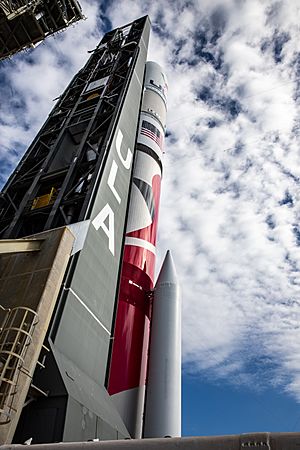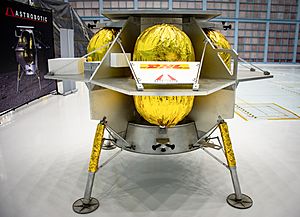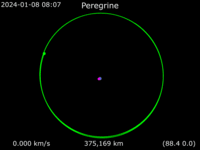Peregrine Mission One facts for kids
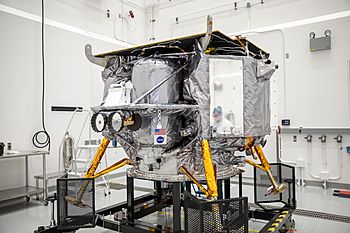
Peregrine ahead of launch
|
|
| Mission type | Lunar landing and surface operations (initially planned), scientific experiments |
|---|---|
| Operator | Astrobotic Technology |
| Mission duration | 10 days (final) One lunar day (14 Earth days) on the lunar surface (initially planned) |
| Spacecraft properties | |
| Spacecraft | Peregrine |
| Launch mass | 1,283 kg (2,829 lb) |
| Start of mission | |
| Launch date | 8 January 2024, 07:18:38 UTC |
| Rocket | Vulcan Centaur VC2S |
| Launch site | Cape Canaveral SLC-41 |
| End of mission | |
| Decay date | 18 January 2024, 21:04 UTC |
| Moon lander | |
| Spacecraft component | Peregrine Lunar Lander |
| Landing date | 23 February 2024 (formerly planned) |
| Landing site | Sinus Viscositatis (Bay of Stickiness, formerly planned) |
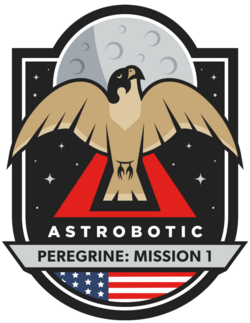 Mission Patch |
|
The Peregrine Lunar Lander flight 01, also known as Peregrine Mission One, was an American space mission. It aimed to land a spacecraft on the Moon. The Peregrine lander was built by a company called Astrobotic Technology. It carried many science tools and other items for NASA's Commercial Lunar Payload Services (CLPS) program.
The mission launched on January 8, 2024. It was the very first flight of the new Vulcan Centaur rocket. The main goal was to be the first U.S. spacecraft to land on the Moon since the Apollo program in 1972.
Sadly, shortly after launching, the lander had a problem. This prevented it from reaching the Moon. After about six days in space, the spacecraft was guided back towards Earth. It safely burned up in Earth's atmosphere over the Pacific Ocean on January 18, 2024.
Contents
Mission Story
In 2017, Astrobotic announced they would launch their Peregrine lander. It would fly on the Vulcan Centaur rocket, built by United Launch Alliance (ULA). This first mission was originally planned for July 2021.
In 2018, NASA chose Astrobotic to be part of its Commercial Lunar Payload Services (CLPS) program. This program helps private companies deliver science tools to the Moon.
In 2019, NASA gave Astrobotic its first contract for 14 payloads. Payloads are the items a spacecraft carries. The mission also had 14 commercial payloads from other companies. These included small rovers like Andy from Carnegie Mellon University.
Other interesting payloads included a special library. It had the entire contents of Wikipedia printed in tiny letters on a nickel disk. Some companies also paid to send human remains to the Moon. This caused concern for the Navajo Nation, who consider the Moon a sacred place.
The launch date was delayed several times. Problems with the rocket and testing pushed the launch from 2021 to 2022, then 2023. Finally, it was set for January 8, 2024.
The Peregrine lander was designed to carry up to 90 kilograms (about 198 pounds) of payloads. It was supposed to land in an area called Mons Gruithuisen Gamma on the Moon.
About the Lander
Astrobotic designed the Peregrine lander in 2016. It was made mostly of aluminum alloy. The lander could be changed to fit different missions.
It had five main engines for powerful movements. These engines helped it travel to the Moon, get into orbit, and land softly. The lander could carry up to 450 kilograms (992 pounds) of fuel.
For steering and staying in the right direction, it used 12 smaller engines. The spacecraft also had special navigation systems. These helped it find its way to the Moon and land precisely.
The Peregrine lander is about 2.5 meters (8.2 feet) wide and 1.9 meters (6.2 feet) tall. It was built to deliver up to 265 kilograms (584 pounds) of payloads to the Moon's surface on future missions.
Its power came from a lithium-ion battery. This battery was recharged by solar panels. The lander was not designed to survive the very cold lunar night, which lasts 14 Earth days. Future versions might be able to.
For talking to Earth, the lander used radio signals. After landing, it could even create a Wi-Fi hotspot. This would let rovers on the Moon communicate with the lander.
Science Payloads
The Peregrine lander carried many important science instruments and other items. These were designed to study the Moon and test new technologies.
Lunar Rovers
| Country | Name | Agency or company | Summary |
|---|---|---|---|
| Colmena×5 | Agencia Espacial Mexicana | This payload included five tiny robots, each weighing less than 60 grams. They were designed to be launched onto the Moon's surface. | |
| Iris | Carnegie Mellon University | Iris is a small, 2-kilogram rover built by university students. It was made of carbon fiber. Its goal was to test how small, light rovers move on the Moon. It would also take pictures and gather data for navigation tests. |
Instruments
| Country | Name | Agency or company | Summary |
|---|---|---|---|
| Laser Retroreflector Array (LRA) | NASA | This device has eight special prisms. They bounce laser light directly back to where it came from. It was designed to help other spacecraft measure their distance to the lander very accurately. It would act like a permanent marker on the Moon. | |
| Linear Energy Transfer Spectrometer (LETS) | NASA | LETS is a radiation monitor. It measures the amount of space radiation. This information is important for keeping astronauts safe on future Moon missions. Radiation on the Moon is much higher than near Earth. | |
| M-42 Radiation Detector | DLR | This detector also measures radiation levels. It works with another experiment on NASA's Artemis I mission. The data helps scientists understand the risks of space radiation for astronauts. | |
| Navigation Doppler Lidar (NDL) | NASA | NDL is a sensor that uses light pulses from a laser. It works like radar but with light. It measures the lander's velocity (speed and direction) and altitude (height above the ground) very precisely during landing. | |
| Near-Infrared Volatile Spectrometer System (NIRVSS) | NASA | This instrument looks for water (H2O) and other gases like CO2 and methane (CH4) on the Moon's surface. It also maps the surface shape and temperature. It was designed to work with rovers and during drilling. | |
| Neutron Spectrometer System (NSS) | NASA | NSS measures neutrons to find out how much hydrogen is in the Moon's soil. Hydrogen can tell us about water or other materials underground. It can measure hydrogen up to three feet below the surface. | |
| Peregrine Ion-Trap Mass Spectrometer (PITMS) | NASA | PITMS studies the Moon's very thin atmosphere, called the exosphere. It helps scientists understand how gases are released and move around on the Moon. This instrument can measure tiny amounts of gases. | |
| Terrain Relative Navigation (TRN) | Astrobotic | Astrobotic planned to test its TRN sensor. This sensor helps spacecraft land on planets with amazing accuracy, within 100 meters of the target. |
Time Capsules
The mission also carried several time capsules and memorial items. These are designed to preserve information or memories for the future.
| Country | Name | Agency or company | Type |
|---|---|---|---|
| Bitcoin Magazine Genesis Plate | BIT Inc. | Plaque | |
| DHL MoonBox | DHL | Commercial payload capsules | |
| Lunar Codex | Incandence | Artwork, books, stories, music | |
| Footsteps on the Moon | Lunar Mission One | Image bank | |
| Luna 02 | Celestis | Memorial capsule | |
| Lunar Bitcoin | BitMEX | Cryptocurrency | |
| Lunar Dream Capsule | Astroscale | Time capsule | |
| Memorial Space Flight Services | Elysium Space | Memorial capsule | |
| Memory of Mankind on the Moon | Puli Space Technologies | Time capsule | |
| MoonArk | Carnegie Mellon University | Lunar Museum | |
| The Arch Libraries | Arch Mission Foundation | Time capsule | |
| Writers on the Moon | https://www.writersonthemoon.com | Stories by 133 authors |
Mission Events
Launch and Journey
Peregrine launched on January 8, 2024, from Cape Canaveral Space Launch Complex 41. The Vulcan Centaur rocket lifted off at 2:18 am EST. The rocket's boosters and first stage separated as planned.
The upper stage then fired its engines twice. The second burn sent the Peregrine lander on a path towards the Moon. The lander separated from the rocket about 50 minutes after launch.
The mission was planned to take 46 days to reach the Moon. It would then enter lunar orbit and slowly approach the surface. The landing was scheduled for February 23, 2024.
Fuel Leak
About seven hours after launch, Astrobotic reported a problem. There was likely an issue with the propulsion (fuel) system. This kept the lander from pointing its solar panels correctly at the Sun.
Engineers quickly worked to turn the spacecraft. They managed to get the solar panels facing the Sun again. This allowed the lander to generate enough power.
However, the problem was a slow fuel leak. The lander had to constantly use its engines to stay stable. Astrobotic announced that the spacecraft would run out of fuel in about 40 hours.
Later, the company confirmed that Peregrine could no longer land on the Moon. Photos from the spacecraft showed damage to its outer layer. This damage might have been caused by a valve that didn't close properly, leading to a fuel tank breaking.
After four days, the fuel leak seemed to slow down. Astrobotic became more hopeful that Peregrine could last longer than expected.
Return to Earth
The spacecraft eventually reached a position where it could have gone to the Moon. But after six days, Astrobotic decided to guide it back to Earth. This was done to prevent it from becoming space debris in space.
The controlled return to Earth's atmosphere happened on January 18, 2024. The spacecraft burned up safely over the South Pacific. This area is sometimes called a "spacecraft cemetery."
What's Next?
Peregrine was the first of NASA's CLPS missions. The next one, Intuitive Machines' IM-1, was set to launch in February 2024. Astrobotic will have another chance to land on the Moon. This will be with their larger Griffin lander and the VIPER rover. That mission was previously planned for November 2024.


